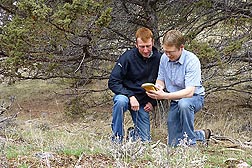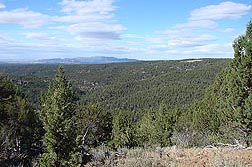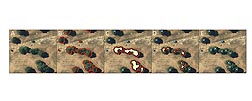Tools for Tracking Troublesome Trees
In Oregon, western juniper trees are expanding their range, pushing out other plant species, reducing sagebrush habitat and livestock forage, and at times fueling catastrophic wildfires. During some of these conflagrations, fires burn even hotter because more wood is available to feed the flames—a cause-and-effect that in turn lengthens the time that temperatures remain elevated at fire-stricken sites.
To help streamline efforts to manage invasive trees, Agricultural Research Service rangeland scientists Kirk Davies and Matt Madsen are investigating ways of combining aerial photography and computer programs to quickly identify and measure affected areas. These tools could save time and money for land managers tasked with protecting sagebrush ecosystems and controlling invasive vegetation.
Scouting for Western Juniper
Davies and Madsen, who work at the Eastern Oregon Agricultural Research Center in Burns, Oregon, led studies on using National Agricultural Imagery Program (NAIP) high-resolution aerial images to estimate western juniper cover. A related part of the project included exploring the relationships between cover of mature stands of juniper and site characteristics that influence soil moisture and temperature.
|
|
Working at a 30,500-acre site in Idaho, they collected information about juniper distribution and then used this data for “training” image software to identify juniper on the NAIP images. Using this calibrated approach—called “feature extraction”—the team identified juniper with an overall accuracy rate of 92 percent. For instance, the NAIP/software combination calculated that 26.8 percent of one site was covered with juniper; initial ground scouting had determined the coverage to be 24.7 percent.
Imagery analysis indicated that the maximum juniper cover in the study area was 82 percent—a figure the scientists validated with ground-truth surveys, which indicated that the maximum juniper cover was 78.7 percent. They found that the western juniper stands with greater cover were more likely to be found at higher elevations and on steeper, more northerly facing slopes.
“Feature extraction gives us a fast-and-easy way to survey a large area and know how much juniper is out there,” says Davies.
Picking Out Pinyon Pine Trees
In collaboration with Brigham Young University, Madsen also led another project that examined the use of high-resolution aerial imagery from the Utah Automated Geographic Reference Center to study the expanse of pinyon-juniper forests in Utah.
“Pinyon-juniper woodlands create the same problems that western juniper woodlands do,” Madsen says. “Lack of resources and extensive and rugged terrain limit a land manager’s ability to monitor pinyon-juniper woodland expansion using traditional field-based methods. The geospatial techniques we developed give land managers the ability to map woodland expansion across large land areas.”
Photographs used by Madsen had been obtained in the fall of 2006—a time when there were distinct differences on the images between the evergreen pinyon-juniper vegetation and seasonally dormant trees, such as gambel oak and bigtooth maple. Madsen “trained” his feature-extraction software to identify pinyon and juniper trees within aerial photographs and then used this data to estimate pinyon-juniper tree cover and density. This method yielded a 93-percent accuracy rate for tree cover.
Madsen’s research was the first to estimate tree density from aerial photographs by using what he calls a “negative buffer post-processing technique.” This method involves reclassifying data from the tree-cover file to generate a unique data point for each tree. He then added up the total number of unique data points to obtain an estimate of tree density. With this method, he obtained a 95-percent accuracy rate in estimating the density of trees that were at least 4-1/2 feet wide.
Ground data indicated that smaller trees that were not identified—primarily juvenile trees—made up only around 1 percent of the total tree cover. But these overlooked trees made up 39 percent of the total number of trees at the site. Madsen showed how ground-based data could be used to develop additional calibrations to the feature-extraction model to account for missing juvenile trees.
The researchers also compared feature-extraction data to ground data for 35 different locations obtained by the Utah Division of Wildlife Resources Range Trend Project (DWR-RTP), which has collected rangeland trend data across the state since 1983.
Madsen’s group was pleased with how well the feature-extracted data correlated with measurements by DWR-RTP. But without calibration, the DWR-RTP data had a higher success rate than the feature-extracted model in detecting juvenile trees. After the feature-extraction program was calibrated to account for juvenile trees, it had almost a 1-to-1 ratio with the DWR-RTP—additional evidence that the process can provide accurate information about tree cover and density.
Madsen says, “This technique could let land managers monitor woodland change over large land areas for a range of things, including woodland encroachment, fuel loads, timber value, wildlife habitat, and grazing suitability.”
Findings from the two studies were published in Rangeland Ecology and Management and Environmental Management.—By Ann Perry, Agricultural Research Service Information Staff.
This research is part of Pasture, Forage, and Rangeland Systems (#215) and Crop Protection and Quarantine (#304), two ARS national programs described at www.nps.ars.usda.gov.
Kirk Davies and Matt Madsen are in the USDA-ARS Range and Meadow Forage Management Research Unit, Eastern Oregon Agricultural Research Center, 67826-A Hwy. 205, Burns, OR 97220; (541) 573-4074 [Davies], (541) 573-8915 [Madsen].
"Tools for Tracking Troublesome Trees" was published in the July 2013 issue of Agricultural Research magazine.









